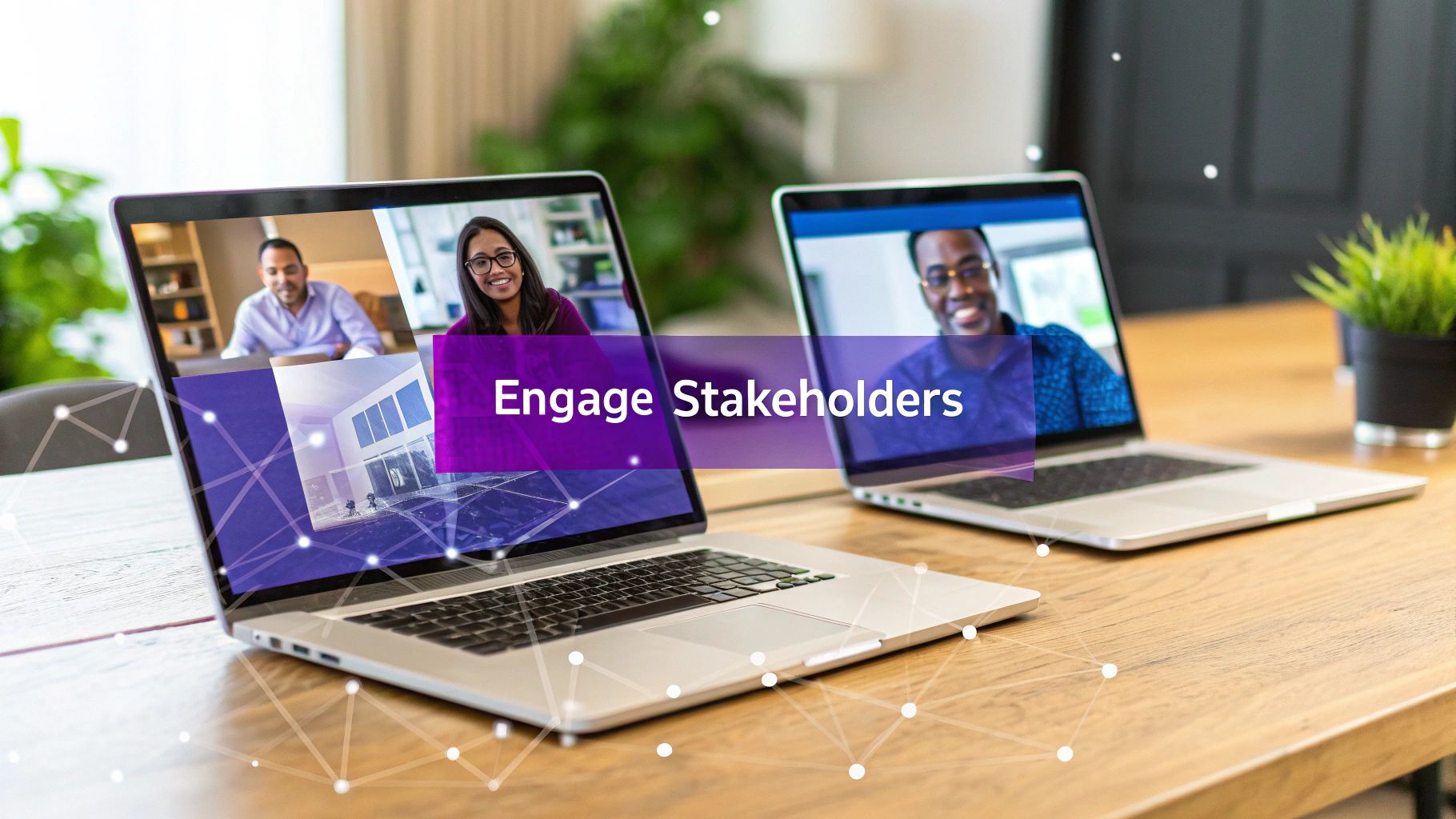In a globally connected work environment, the success of any project, product, or initiative depends on more than just internal execution. It’s shaped by a diverse ecosystem of stakeholders, including customers, employees, investors, and community members. Overlooking their perspectives is a direct path to missed opportunities and preventable roadblocks. The real challenge, especially for distributed teams, is moving beyond basic communication to build genuine, collaborative partnerships.
Effective stakeholder engagement strategies are the key to unlocking this potential. They turn passive audiences into active contributors, fostering a shared sense of ownership and purpose. This guide dives into 10 proven methods for building and maintaining strong stakeholder relationships. We won’t just tell you what to do; we’ll show you how with a clear roadmap for each strategy.
You will find actionable implementation steps, practical advice for remote team dynamics, and clear examples to help you put these ideas into practice immediately. Our goal is to equip you with the tools to ensure every crucial voice is not just heard but also integrated into your project’s DNA, driving sustainable success from every angle.
1. Stakeholder Mapping and Analysis
Before you can engage stakeholders, you must first understand who they are and what they care about. Stakeholder mapping is a foundational strategy for identifying and categorizing everyone involved in or affected by your project. The most common method, Mendelow’s Power/Interest Grid, plots stakeholders based on their level of influence (power) and level of concern (interest).
This visual analysis helps prioritize your communication efforts. For instance, a high-power, high-interest stakeholder (like a primary investor) requires close management and frequent, detailed updates. In contrast, a low-power, low-interest stakeholder might only need occasional monitoring through general communications like a company newsletter. This process ensures you allocate your resources effectively, making it one of the most crucial stakeholder engagement strategies for any team.
How to Implement It
- Identify & Categorize: Brainstorm all potential stakeholders, from internal team members to external regulators. Plot each one on a four-quadrant grid (High Power/High Interest, High Power/Low Interest, etc.).
- Analyze & Plan: For each quadrant, define a specific engagement approach. For example, “Keep Satisfied” for high-power, low-interest groups. This analysis often runs parallel to early-stage user research, which helps in understanding their needs more deeply. You can discover how to conduct effective user research to complement this process.
- Review & Update: Stakeholder positions can change. Revisit your map quarterly or whenever a significant project shift occurs to ensure your strategies remain relevant.
Pro-Tip for Remote Teams: Use a collaborative digital whiteboard tool like Miro or Mural for your mapping session. This allows all distributed team members to contribute in real-time, capturing diverse perspectives and fostering shared ownership of the engagement plan.
2. Two-Way Communication and Dialogue
Effective engagement is a conversation, not a broadcast. This strategy moves beyond one-way information pushes to create a genuine dialogue where stakeholders can voice concerns, ask questions, and contribute ideas. Instead of simply telling stakeholders what’s happening, you actively invite them into the conversation, building trust through transparency and showing their input is genuinely valued.
This approach transforms stakeholders from a passive audience into active partners. Companies like Patagonia use stakeholder forums to discuss environmental initiatives, while local governments hold town halls to gather citizen feedback. By creating these feedback loops, you not only gain valuable insights but also foster a stronger, more resilient relationship, making this one of the most powerful stakeholder engagement strategies for long-term success.

How to Implement It
- Establish Channels: Create dedicated spaces for dialogue, such as regular Q&A sessions, feedback portals, advisory boards, or online forums. Ensure these channels are accessible to all key stakeholder groups.
- Practice Active Listening: Train your team to listen for understanding, not just to respond. Document conversations, acknowledge all feedback promptly, and transparently share how input is being used to make decisions. Effective dialogue requires you to find ways to overcome communication barriers that might otherwise stifle honest exchanges.
- Create Psychological Safety: Foster an environment where stakeholders feel safe to share honest, even critical, feedback without fear of negative consequences. This is crucial for uncovering potential risks and opportunities you might otherwise miss.
Pro-Tip for Remote Teams: Use asynchronous tools like Slack or dedicated feedback channels in your project management software to maintain an ongoing dialogue. Host virtual “office hours” or “ask me anything” (AMA) sessions with project leads to give stakeholders direct, predictable access for live conversation.
3. Collaborative Co-Creation and Partnerships
Moving beyond simple consultation, this advanced strategy involves inviting stakeholders to actively participate in designing solutions, products, or processes. Co-creation transforms stakeholders from passive recipients into active partners, leveraging their unique expertise and insights. This approach, seen in platforms like LEGO Ideas where users submit new set designs, fosters a deep sense of ownership and mutual value.

When stakeholders contribute directly, the final output is not only more aligned with their needs but also gains built-in advocates. This method is one of the most powerful stakeholder engagement strategies because it builds lasting relationships and drives innovation. Beyond individual interactions, building a robust and collaborative environment is key; strategies for achieving this include understanding how to go about forming a thriving community to support these partnerships long-term.
How to Implement It
- Define Clear Boundaries: Establish clear roles, responsibilities, and decision-making processes from the outset. This ensures everyone understands how their contributions will be used and who has the final say.
- Provide Resources & Support: Equip stakeholders with the tools, information, and support they need to participate effectively. This could include access to internal experts, dedicated communication channels, or compensation for their time. This is a core part of effective collaborative decision-making.
- Celebrate & Communicate: Acknowledge all contributions and celebrate co-created achievements publicly. This reinforces the value of the partnership and encourages continued engagement.
Pro-Tip for Remote Teams: Use dedicated digital collaboration platforms like Batterii or InVision Freehand to create structured co-creation spaces. These tools allow asynchronous and synchronous contributions, making it easy for stakeholders across different time zones to participate meaningfully.
4. Transparency and Open Communication
Building trust is the cornerstone of effective stakeholder relationships, and nothing builds trust faster than transparency. This strategy involves openly sharing information, decisions, processes, and even challenges with stakeholders. By providing a clear view into your operations, you demystify your actions and build credibility. Even when the news isn’t positive, such as Tesla’s direct communication about production delays, honesty prevents misinformation and shows respect for your stakeholders’ involvement.
This approach transforms the dynamic from a one-way broadcast to a two-way dialogue, making stakeholders feel like valued partners. Companies like Buffer, known for its radical transparency on salaries and equity, prove that openness can foster a powerful sense of community and loyalty. Adopting transparency is one of the most impactful stakeholder engagement strategies because it addresses the core human need for certainty and inclusion.
How to Implement It
- Establish Clear Guidelines: Define what information will be shared, with whom, and through which channels. Create protocols for communicating both good and bad news to ensure consistency.
- Explain the ‘Why’: Don’t just announce decisions; explain the reasoning and data behind them. This context helps stakeholders understand the bigger picture and aligns them with your organizational direction. It’s a key tactic for leaders who want to learn more about building trust within their teams.
- Be Proactive: Address potential issues and concerns before they escalate. Openly discussing challenges shows confidence and allows stakeholders to contribute to solutions rather than just react to problems.
Pro-Tip for Remote Teams: Create a dedicated “transparency channel” in your communication platform (like Slack or Teams). Use it to share key metrics, project updates, and leadership notes. This creates a centralized, accessible hub for important information, ensuring everyone stays informed regardless of their time zone.
5. Stakeholder Education and Capacity Building
Instead of just informing stakeholders, a proactive approach is to actively educate and empower them. This strategy involves investing in programs that build stakeholders’ knowledge and skills related to your project, industry, or shared goals. When stakeholders are better informed, they can provide more valuable feedback, make better decisions, and become more effective partners.
This method transforms the relationship from a simple broadcast of information to a collaborative partnership built on shared understanding. Companies like Salesforce, with its Trailhead platform, exemplify this by educating customers to maximize product value, thereby increasing loyalty and success. This is one of the more advanced stakeholder engagement strategies, as it focuses on long-term value creation and mutual growth, rather than just immediate project needs.
How to Implement It
- Tailor Learning Content: Develop educational materials specific to different stakeholder groups. For instance, supply chain partners might receive workshops on sustainability practices, while end-users could get access to a self-paced online course about new product features.
- Use Diverse Formats: Offer learning opportunities through various channels like webinars, in-person workshops, and e-learning modules. This caters to different learning styles and availability. You can discover effective methods for planning workshops to engage stakeholders directly.
- Measure and Recognize: Track completion rates and assess knowledge retention to measure the program’s effectiveness. Offer certifications or badges to recognize participants’ achievements, which adds value and encourages participation.
Pro-Tip for Remote Teams: Use a Learning Management System (LMS) or a platform like Teachable to create a centralized, on-demand hub for all educational resources. This allows distributed stakeholders across different time zones to access training materials at their own convenience.
6. Stakeholder Advisory Boards and Councils
For organizations seeking deep, structured input, forming a stakeholder advisory board or council is a powerful strategy. This approach creates a formal group of representatives from key stakeholder segments who meet regularly to provide guidance and feedback on high-level decisions, policies, and strategic direction. It formalizes the stakeholder voice, moving beyond ad-hoc feedback to a structured, influential role in governance.
Establishing an advisory board demonstrates a profound commitment to incorporating stakeholder perspectives into the very fabric of the organization. For instance, a university might have a council with student, alumni, and local business leaders to guide its curriculum development. This method is one of the most impactful stakeholder engagement strategies because it builds long-term, collaborative relationships and ensures that decision-making is consistently informed by those it affects most.
How to Implement It
- Define Purpose & Authority: Clearly articulate the board’s mandate, scope of influence, and decision-making authority. Will its recommendations be advisory or binding? This clarity prevents future conflicts and manages expectations.
- Recruit Diverse Members: Intentionally select representatives from a wide range of key stakeholder groups to ensure a variety of perspectives. Rotate membership periodically to introduce fresh ideas and prevent stagnation.
- Structure & Support: Establish a regular meeting cadence, provide necessary resources, and create clear channels for the board’s recommendations to reach leadership. Document and share the outcomes of these meetings to maintain transparency and momentum.
Pro-Tip for Remote Teams: Host virtual council meetings using video conferencing tools with advanced features like breakout rooms for smaller group discussions and polling to gauge consensus efficiently. A dedicated digital portal or Slack channel can keep members engaged and informed between formal meetings.
7. Digital and Social Media Engagement
In today’s connected world, engaging stakeholders often means meeting them where they are: online. Digital and social media engagement is a modern strategy that leverages platforms like Twitter, LinkedIn, and online forums to foster real-time interaction and build community. This approach allows organizations to reach a broad audience, listen to conversations as they happen, and share valuable content that builds trust and loyalty.

Companies like Starbucks and JetBlue excel at this, using their social channels not just for promotion but for responsive customer service and genuine dialogue. Effective digital outreach transforms one-way communication into a dynamic conversation, making it one of the most scalable stakeholder engagement strategies available. This method is particularly effective for engaging customers, industry influencers, and the general public.
How to Implement It
- Monitor & Listen: Use social listening tools to track mentions of your brand, project, and relevant keywords. Actively monitor community hubs like Reddit or specialized forums where stakeholders congregate.
- Engage Authentically: Respond promptly and transparently to comments, questions, and concerns. Share valuable, non-promotional content that addresses stakeholder interests and establishes your organization as a thought leader.
- Build Community: Create dedicated spaces for interaction, such as a LinkedIn group, a Slack channel for power users, or a Discord server. For fostering vibrant online communities and extending your reach, consider exploring the impact of dedicated chat messaging for online communities and social networks.
- Measure & Adapt: Use platform analytics to understand what content resonates with your audience. Track metrics like engagement rate, sentiment, and reach to refine your approach continuously.
Pro-Tip for Remote Teams: Assign a “social media point person” for specific projects or campaigns. This individual can monitor channels and coordinate responses with the appropriate team members, ensuring a consistent and timely voice even when the team is distributed across different time zones.
8. Regular Feedback Loops and Continuous Improvement
Engaging stakeholders isn’t a one-time event; it’s an ongoing conversation. Establishing regular feedback loops is a powerful strategy for systematically collecting, analyzing, and acting on stakeholder input. This approach transforms feedback from a simple data point into a catalyst for continuous improvement, demonstrating to stakeholders that their voices directly influence project outcomes and organizational direction.
This cycle of listening and responding builds trust and reinforces partnership. When stakeholders see their suggestions lead to tangible changes, like Amazon using customer reviews to refine product features or agile teams adjusting backlogs after sprint reviews, they become more invested. This iterative process makes your project more resilient and aligned with stakeholder needs, solidifying its place among the most effective stakeholder engagement strategies.
How to Implement It
- Establish Clear Channels: Create simple, accessible ways for stakeholders to provide input, such as dedicated email addresses, regular surveys, or scheduled review meetings. The lower the friction, the higher the participation.
- Analyze and Prioritize: Not all feedback can be acted upon immediately. Triage suggestions based on impact, feasibility, and alignment with project goals. Document decisions and reasoning clearly.
- Close the Loop: This is the most critical step. Communicate back to stakeholders what you heard, what you plan to do, and why. Even if you don’t implement a suggestion, explaining the reasoning shows their input was valued.
- Measure and Share Results: Track the impact of the changes made based on feedback. Share success stories and data-driven results to reinforce the value of the feedback loop and encourage future participation.
Pro-Tip for Remote Teams: Use asynchronous feedback tools like Loom for video walkthroughs or dedicated Slack channels for ongoing conversations. This allows stakeholders in different time zones to provide thoughtful input without the pressure of a live meeting, fostering more inclusive and detailed feedback.
9. Conflict Resolution and Issues Management
Disagreements are an inevitable part of any complex project. A proactive approach to conflict resolution is a powerful strategy for addressing disputes before they derail your progress. This involves creating systematic processes for identifying, discussing, and resolving issues between stakeholders, or between stakeholders and the organization, in a way that preserves relationships.
Rather than viewing conflict as a negative, this method reframes it as an opportunity for clarification and alignment. By using techniques like mediation, negotiation, and collaborative problem-solving, teams can navigate disagreements to find mutually beneficial outcomes. Effective conflict management is one of the most essential stakeholder engagement strategies for maintaining trust and ensuring project momentum, especially when interests diverge.
How to Implement It
- Establish a Clear Process: Create and communicate a formal process for raising and addressing issues. This could be a dedicated channel, a specific meeting agenda item, or an issues log that tracks problems from identification to resolution.
- Focus on Interests, Not Positions: Encourage stakeholders to articulate the underlying needs and goals behind their stated positions. This approach, popularized by negotiation experts like Roger Fisher, helps uncover common ground and opens the door for creative, win-win solutions.
- Mediate and Document: When conflicts are complex or emotionally charged, consider bringing in a neutral third-party facilitator. Once an agreement is reached, document it clearly and outline the next steps and follow-up mechanisms to ensure accountability.
Pro-Tip for Remote Teams: Use asynchronous communication tools like dedicated Slack channels or shared documents to log issues as they arise. This allows stakeholders in different time zones to contribute their perspectives calmly and thoughtfully before a real-time resolution meeting is scheduled, preventing knee-jerk reactions.
“Stakeholders felt heard, and we left with a clear shortlist of priorities instead of a messy wall of ideas.”
10. Customized Engagement Plans and Segmentation
A one-size-fits-all approach to communication rarely works. Customizing engagement plans involves segmenting stakeholders based on their needs, preferences, and characteristics, then tailoring your approach accordingly. Instead of sending the same generic update to everyone, this strategy recognizes that different groups require different communication channels, frequencies, and levels of detail.
This targeted method ensures your messages are relevant and impactful. For example, a tech company would engage developers with technical documentation and API updates, while engaging enterprise clients with high-level business value propositions and ROI case studies. This level of personalization makes stakeholders feel understood and valued, significantly improving the effectiveness of your stakeholder engagement strategies.
How to Implement It
- Segment Your Stakeholders: Group stakeholders based on shared attributes like their role, department, interest level, or communication preferences. Use data from surveys, interviews, and past interactions to inform these segments.
- Develop Tailored Plans: For each segment, define the key messages, preferred channels (e.g., Slack, email, video calls), frequency of contact, and desired outcomes. Document this logic clearly for your team.
- Execute and Gather Feedback: Roll out your customized communication and actively seek feedback. Ask stakeholders if the frequency and format meet their needs and adjust your plans based on their input.
Pro-Tip for Remote Teams: Use your CRM or a dedicated communication tool to tag stakeholders by segment. This allows you to automate targeted messaging and track engagement metrics for each group, ensuring no one falls through the cracks in a distributed environment.
10-Point Stakeholder Engagement Strategy Comparison
| Strategy | Implementation complexity 🔄 | Resources & speed ⚡ | Expected outcomes 📊 | Key advantages ⭐ | Quick tip 💡 |
|---|---|---|---|---|---|
| Stakeholder Mapping and Analysis | Medium — structured workshops and data collection | Moderate resources; slower initial setup | Clear prioritization; targeted engagement; early risk identification | ⭐⭐⭐⭐ — focuses effort where it matters most | Update maps regularly; involve diverse team members |
| Two-Way Communication and Dialogue | High — ongoing facilitation and cultural change | High resource and time commitment; continuous effort | Stronger trust; early issue detection; greater buy-in | ⭐⭐⭐⭐ — builds authentic relationships and insight | Create psychological safety and respond promptly |
| Collaborative Co-Creation and Partnerships | High — coordination, shared governance, co-design | High resources; long-term investment; slow to realize outcomes | More innovative solutions; stronger ownership; durable relationships | ⭐⭐⭐⭐⭐ — leverages stakeholder expertise for innovation | Define roles, decision rules, and resources up front |
| Transparency and Open Communication | Medium — policies, protocols, consistent execution | Low–Medium resources; can be implemented quickly but needs discipline | Increased credibility; reduced rumors; higher accountability | ⭐⭐⭐⭐ — builds trust and attracts aligned stakeholders | Explain the “why” behind decisions; use multiple channels |
| Stakeholder Education and Capacity Building | Medium–High — curriculum design and tailoring | High resources; time to impact; slower ROI | Empowered stakeholders; improved decisions; long-term advocates | ⭐⭐⭐⭐ — raises stakeholder capability and sustainability | Use mixed formats and measure learning outcomes |
| Stakeholder Advisory Boards and Councils | Medium — governance design and member management | Moderate resources; scheduled cadence; steady influence | Structured input to leadership; legitimacy; accountability | ⭐⭐⭐⭐ — formalized stakeholder voice in decisions | Ensure real authority, clear mandate, and rotation |
| Digital and Social Media Engagement | Low–Medium — platform setup and moderation | Variable resources; ⚡ enables real‑time reach but needs constant monitoring | Broad reach; real‑time feedback; community building; sentiment data | ⭐⭐⭐⭐ — scalable engagement and rich analytics | Monitor channels, respond authentically, set moderation rules |
| Regular Feedback Loops and Continuous Improvement | Medium — systems for collection, analysis, action | Moderate resources; iterative processes; ⚡ continuous improvement | Visible responsiveness; ongoing improvements; emerging issues identified | ⭐⭐⭐⭐⭐ — links stakeholder input to demonstrable change | Close the loop: show what changed because of feedback |
| Conflict Resolution and Issues Management | High — skilled facilitation and formal protocols | Moderate–High resources per case; often time‑intensive | Prevents escalation; preserves relationships; fair resolutions | ⭐⭐⭐⭐ — maintains trust and mitigates risk | Address issues early; use neutral mediators when needed |
| Customized Engagement Plans and Segmentation | High — data-driven segmentation and tailored plans | High resources initially; ⚡ efficient once established | Higher relevance; improved engagement; better resource allocation | ⭐⭐⭐⭐⭐ — maximizes impact through targeted approaches | Base segmentation on data; be transparent about differences |
Turning Engagement into Your Competitive Advantage
The journey to effective stakeholder engagement doesn’t end with reading a list. It begins with a commitment to transforming relationships from transactional interactions into strategic partnerships. We’ve explored ten powerful stakeholder engagement strategies, from the foundational work of mapping and analysis to the dynamic processes of co-creation and continuous feedback. Each strategy offers a distinct pathway to building trust, fostering alignment, and unlocking hidden value.
However, the true power of these approaches is not in their isolated application. It’s in weaving them together into a cohesive, ongoing practice that becomes a core part of your organization’s DNA. For remote and hybrid teams, this means being even more intentional about creating spaces for dialogue and collaboration. The goal is to move beyond simply managing stakeholders to actively championing their involvement.
From Strategy to Actionable Practice
To make these concepts a reality, focus on three key takeaways:
- Be Proactive, Not Reactive: Don’t wait for a crisis to engage. Start with stakeholder mapping and customized engagement plans to build strong relationships before you need them. Proactive engagement turns potential roadblocks into valuable allies.
- Prioritize Two-Way Communication: Engagement is a dialogue, not a monologue. Implement regular feedback loops, advisory boards, and digital platforms that give stakeholders a genuine voice. Listening actively is just as important as communicating clearly.
- Embrace Collaboration: The most innovative solutions often come from co-creation. Involve stakeholders directly in problem-solving and decision-making to build shared ownership and generate outcomes that are more robust, relevant, and sustainable.
By mastering these stakeholder engagement strategies, you do more than just improve project outcomes. You build organizational resilience, enhance your reputation, and create a powerful competitive advantage. When stakeholders feel heard, valued, and included, they become your most powerful advocates, partners, and champions for long-term success. The initial investment in building these relationships pays dividends in loyalty, innovation, and a smoother path to achieving your most ambitious goals.
Ready to supercharge your stakeholder workshops and co-creation sessions? Bulby provides the structured, collaborative tools your remote or hybrid team needs to turn great ideas into actionable outcomes. Facilitate dynamic discussions, gather insightful feedback, and ensure every voice is heard by exploring Bulby today.

